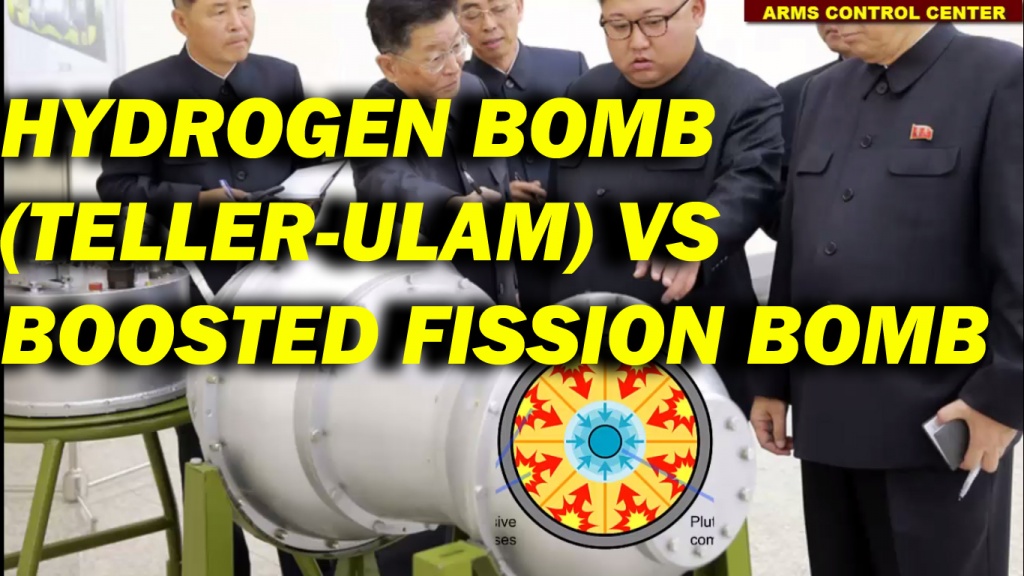Σεπ 08 2017
North Korean Hydrogen bomb (Teller-Ulam) vs boosted fission bomb
Δημοσιευμένο από EKĖO στην κατηγορία ΠΥΡΗΝΙΚΑ ΟΠΛΑ, Ετικέτες: boosted fission weapon, fission weapons, hydrogen bomb, North Korea, North Korean hydrogen bomb, North Korean nuclear weapon, Teller-Ulam, Teller-Ulam designΑναδημοσίευση από τη διεθνή ιστοσελίδα του EKEO
The reason why Kim Jong-Un was photographed displaying this strange peanut-like gadget is because he wanted to persuade the international community that his nuclear device is not simply a boosted fission weapon but instead a genuine Teller-Ulam design hydrogen bomb. The yield of his most recent nuclear test was definitely above 100 kilotons thus upgrading the North Korean Nuclear weapons to at least the class of boosted fission weapons whose yield is smaller than that of a hydrogen weapon but larger than the energy of primitive fission weapons. He is therefore desperate to prove that he possesses a hydrogen bomb and not simply a boosted fission weapon. It is common knowledge that a boosted fission weapon is spherical in shape as it is actually a spherical plutonium pit surrounded by spherical layers of reflecting metals and explosives(converging explosive lenses). In the past he was photographed in front of a device which was a replica of a miniaturized implosion assembly plutonium bomb conveying the message that he possesses at least a Fat-Man type nuclear bomb. Recently he was photographed in front of that peanut-shaped device in order to convince the public that his device is a two-stage radiation implosion assembly that is a hydrogen bomb of the so-called Teller-Ulam design. One of the lobes is supposed to represent the first stage or the trigger of the hydrogen bomb which is actually a boosted fission weapon and the other lobe is supposed to represent the second stage which contains the thermonuclear material (deuterium and tritium) and will be imploded by the x-rays emitted from the first stage. Hydrogen bombs of the Teller-Ulam design guarantee explosion energies in the megaton range while fission bombs, even if they are boosted ones, can yield up to several hundreds of kilotons so the issue here is whether North Korea has joined the hydrogen bomb superpowers. However, even hydrogen bombs such as the American B61 gravity bomb stored in various NATO nuclear bases around the world is designed to yield up to several hundreds of kilotons. This fact proves that the yields of boosted fission weapons such as those possessed by North Korea currently overlap with the yields of the modern hydrogen bombs in the American nuclear arsenal.
The preceding analysis of the Arms Control Center proves a very important fact: It is of no importance anymore whether North Korea has a genuine hydrogen bomb as the explosion energy of its recent test is comparable to the energy of most operational hydrogen bombs of other nuclear weapons states. The burning issue is whether North Korea has attained the miniaturization technology required to mount a fully functional thermonuclear bomb onto a means of delivery such as a ballistic missile or a simple primitive gravity bomb. Unfortunately, this riddle can only be resolved in the same way that the USA proved the capabilities of the American nuclear arsenal, that is by displaying publicly a nuclear device, mounting that very device onto a means of delivery and then detonating it on a target so that the world can witness the true level of sophistication of the North Korean nuclear weapons. Let’s pray that this will never happen.

 Άρθρα (RSS)
Άρθρα (RSS)